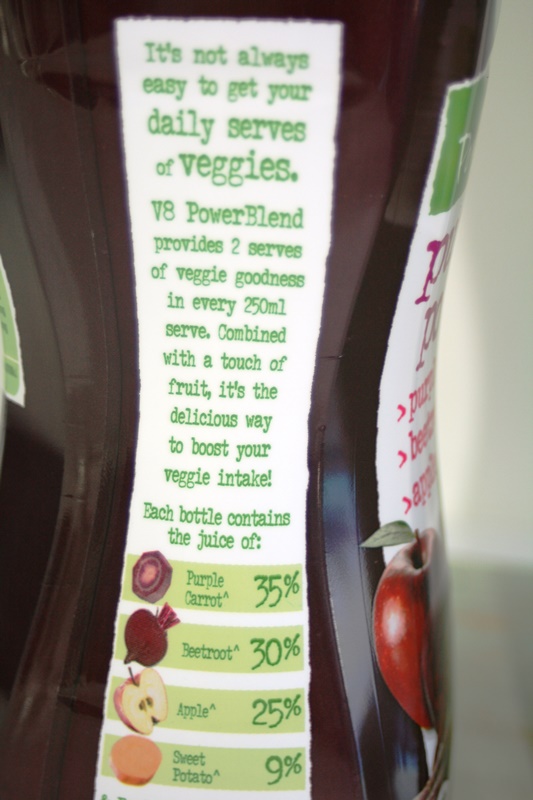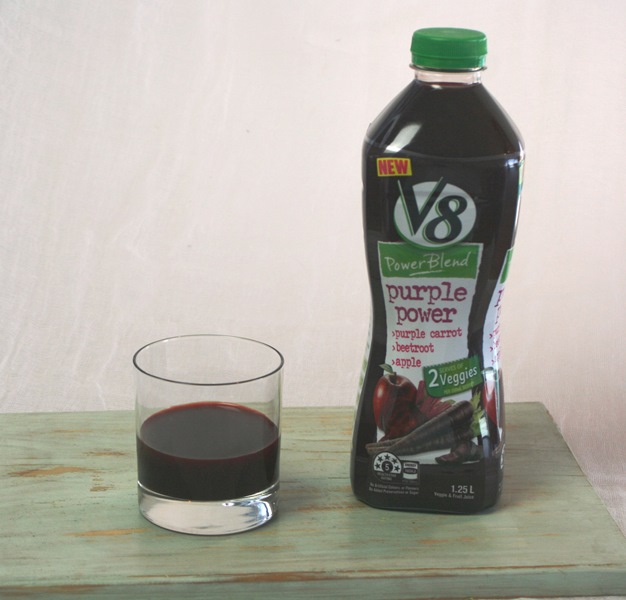Product Review: V8 Power Blend Juices
Written by Catherine Saxelby
on Wednesday, 01 February 2017.
Tagged: convenience, healthy eating, juice, nutrition, review, vegetables

Convenience and taste have become the main criteria for our weekly supermarket shop. However, as the trend towards a more healthy diet with increased quantities of fruit and veg catches on, nutrition is becoming just as important. Enter the market, ready-to-drink juices. There are now whole aisles dedicated to them but they’re mostly made from fruit. There’s not much in the way of veg or fruit/veg combos, except Power Blend veg-fruit juices. So let’s take a look to see how they measure up

This post has been sponsored by Campbells
Save
Save
Save
Save
Save
Save
Save
Save
Three vegie-based juices
These three Campbell’s Power Blend juices are part of their V8 range of vegetable-based juices that have been around since the classic V8 (with its combo of 8 vegetables) first appeared in 1933. They are interesting blends of vegetables with a dash of fruit juice which “dilutes” the natural fruit sugars from juice, adds flavour and reduces the kilojoules you finally consume. I find them an easy way to help you increase your intake of vegetables.
There are three variants in the Campbell’s Power Blend range. All provide 2 serves of vegetables from a glass. These variants are:
- Purple Power
- Healthy Greens
- Orange Kick
I assembled five tasters with a mix of male, female and age ranges. The tasters could not see the brand of juice being tasted as I had wrapped the bottles. However they could easily see the strong colours of purple, green and orange.
Taste: 7 out of 10
We rated the Purple Power the best tasting at 8, followed by the Orange Kick at 7 and Healthy Greens the least favourite at 5. This gives an average score of 7.
Unlike other vegie juices, one good point is that these do not separate into a thick, distinct layer of sludge with the liquid on top. Whilst you are advised to “shake before use”, there was never much sediment on the bottom at any time, which is testament to the food technologists who developed these products.
Nutrition: 17 out of 20
For me, the biggest attraction is that you get vegetables from a juice! From a 250 mL serve (a glass), you get the equivalent of two serves of veggies, which is very impressive!
Health Star Rating (HSR): All three juices scored a top of 5 out of 5 Stars, the highest you can get. This is due to the fact that they have no fat, no added sugar, no added salt and a huge content of vegetables and fruits, which all rank highly on the HSR algorithm.
All of these juices boast that they have no preservatives and no artificial flavours or colours, which is true, but see Sustainability later.
All these juices claim to have no added sugar. Given the negative feeling towards sugar at the moment, this can only be a good thing. However the official government guide only allows you to count 1/2 cup (125 mL) juice as ONE serve of fruit or vegetable a day, owing to the fact that all juices are liquid calories and easy to over consume.
The Orange Kick stands out for its beta-carotene (which is converted into vitamin A once in the body) due to the naturally occurring compounds from the carrots.
The packaging boasts that these juices are a “good source of powerful antioxidant vitamin C” which is added. Yet the final amounts are surprisingly low. It is only due to the serve size of 250 mL that you get 10 mg of vitamin C, which is 20 per cent of the Recommended Dietary Intake (RDI) for adults.
All are very low in sodium (salt) as expected.
All have a low fibre content due to the pulp being discarded during processing. This is not uncommon but is something to keep in mind. Juices are NOT equivalent to eating whole carrot, pumpkin or beetroot. (See my post Juice is Not the same as whole fruit and while this post is about fruit juice some of the caveats apply to vegie juices as well.)
Like all juices, they also have negligible fat and protein content, so we have not reported these figures in the table below.
Nutritional figures
Per 100 mL (less than ½ a glass)
| Compound |
Purple Power | Healthy Greens | Orange Kick |
| Energy | 165 kJ/39 Cal | 165 kJ/39 Cal | 122kJ/29 Cal |
| Sugars | 7.5g | 6.0g | 5.7g |
| Fibre | 0.3g | 0.5g | 0.3g |
| Sodium | 37mg | 33mg | 71mg |
| Vitamin C | 4mg | 4mg | 3mg |
Taken from the label except for vitamin C which comes from their website.
What are the ingredients in Power Blends?

Purple Power:
| Purple carrot (35%), beetroot (30%), apple (25%), sweet potato (9%), food acid (citric acid), vitamin C, natural flavour. |
Unbelievable that it was soooo dark purple with around equal contributions from purple carrots (how different!) and beetroot. Plus an unusual presence of sweet potato which I would never have thought of in juice!
Healthy Greens:
| Yellow carrot (54%), apple (36%), green veggie blend (6% - spinach, cucumber, celery, green bell pepper, kale, lettuce), pineapple (3%), food acid (citric acid), vitamin C, natural flavours, natural colour (E141). |
141 is the code number for chlorophyll, the natural-occurring green pigment of plants. Nothing sinister here. But no idea why it features an ‘E’ before it which is only required in European countries, not in Australia. We checked with Campbells and were told that the juice isn’t sold in the EU. But:
“The ‘E’ was thought to be more consumer friendly, as it’s part of an international code, for people who read different languages. The additive has been approved for use by regulatory agencies around the globe.”
Orange Kick:
| Carrot (97%), mango (2%), food acid (citric acid), vitamin C, natural flavour. |
Yep, it’s mostly carrot juice. Our panel was surprised to find that there is NO orange juice in the Orange Kick blend.
Key ingredients
The key ingredients of interest here are the vegetables which far outweigh the amount of fruit. It seems that the fruit juice is added to balance the taste of the strong vegetable flavour which makes the final products more palatable, whilst still being mainly a vegetable juice. None of these juices tasted sweet to our panel.
Convenience: 9 out of 10
Nothing to prepare or cook - simply shake, open and pour. They come in a large 1.25 L bottle which would not suit a single person household. Given that they have to be consumed within 5 days of opening, it’s clear they are aimed at families or larger households.
We note these don’t have the convenience of a single serve. Perhaps if these sell well Campbell’s will introduce single serve options like their V8 250 mL Breakfast Fusion juice in the future?
However we do feel that 250 mL is too big a portion for this style of drink, not only from a nutrition viewpoint but also as they are quite filling. So we suggest perhaps a 125 mL mini-bottle or a multi-pack?
All three juices have 12 months of shelf-life stamped on their Best-Before date. So how can a juice keep for 12 months without chemical preservatives? We were told:
“The combination of commercially-sterilizing the juice through ultra-high temperature processing (UHT) and then packaging it in a PET bottle results in the shelf stable V8 juices without chemical preservatives or refrigeration. The UHT eliminates bacteria in juice and PET packaging is controlled in a way to keep juice out of air or contaminants that could cause spoilage.”
So the processing and packaging work nicely together. No need for chemicals.
Sustainability 8 out of 10
All the bottle is completely recyclable, including the lid. The juice is listed as reconstituted. Campbells told us that they always aim to source the juices in Australia. However they are sometimes forced to source them from other countries, when Australian-grown ingredients are not available or do not meet their specifications. So the exact origin may vary based on seasonal availability. However they “expect all ingredients to meet their strict quality criteria and they audit suppliers to ensure they meet these standards.” My take is that most of the time, the juices come from Australia but you have no way of knowing. This takes a point off the rating here.
Overall score 41 out of 50 or 4 apples

More details at the website www. campbells.com search for V8 Blends once on the site.
The final word
I would purchase these again as they tick all my nutrition boxes and taste really, really nice. I find them refreshing without being sweet and I have been using them as a base topped up with sparkling mineral water, especially on hot days.
I would purchase these again as they tick all my nutrition boxes and taste really, really nice. Refreshing without being sweet.
I feel they can replace fruit juice and would suit anyone hosting a gathering or a larger household where juice remains a staple in the fridge.
I love it that V8 juices make vegetables appealing and convenient. Plus there’s the convenience of juice without the fruit being “overbearing”. A winner in my book.
Thanks to Debbie, Caitlin, David and Guy who participated with me in the taste test.
Save
Save
Save
Save
Save
Save
Save
Save
You may also be interested in...
Foodwatch
The Good Stuff
The Boring Stuff
© 2025 Foodwatch Australia. All rights reserved
Website by Joomstore eCommerce










